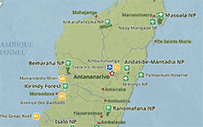While many visitors to Madagascar come for the beautiful beaches, the island is a top ecotourism destination thanks to its 50 national parks and reserves. If you like an active holiday, Madagascar won’t disappoint as most wildlife viewing is done on foot. For a true adventure, you can even go out at night, looking for animals by flashlight.

Pros & Cons
Wildlife
Madagascar is a diversity hot spot, offering a unique kind of safari. You won’t see the ‘normal’ safari animals here – there are no elephants or lions. Instead, the island is home to more than 100 species of lemurs, from the large indri to tiny dwarf lemurs, as well as an abundance of reptiles, amphibians and birds. Most of these are found only in Madagascar. Of particular interest are the chameleons.
Activities
Madagascar is a world-class hiking destination, and this is the major activity you’ll get to enjoy when on safari here. While hiking, you’ll be looking for wildlife, particularly lemurs, chameleons and birds. Night walks are also possible, although not usually inside the national parks. Boat excursions (including whale watching) and diving and snorkeling are popular activities in coastal areas.
Weather & Climate
Madagascar has a hot tropical climate, but there are big regional variations. In the highlands of the interior, you’ll experience a cooler and less humid climate. There is a lot of rain throughout the year on the east coast, but the south of the island is usually hot and dry. There are, however, Wet (November to April) and Dry (May to October) seasons throughout the country, although the Dry season can start in April or May, depending on the area.
Best Time To Visit
The shoulder months of April, May, October and November are the ideal travel times in most areas, although there are some regional variations between parks. The cool, dry months from June to August or September are very pleasant, but these months are less rewarding for wildlife viewing because many animals (including lemurs) are less active during cooler weather. January to March is the height of the Wet season. This is also referred to as cyclone season, and the east coast is particularly at risk at this time. July, August and the December holidays are best avoided due to crowds.











